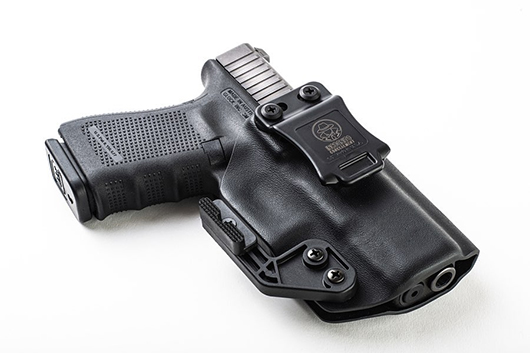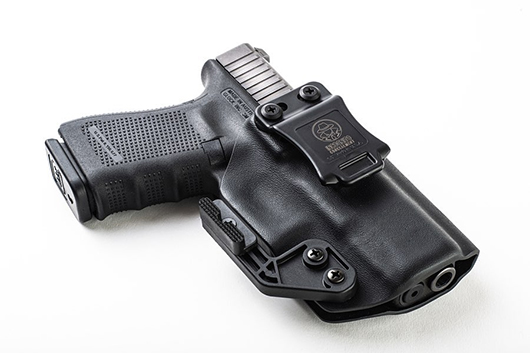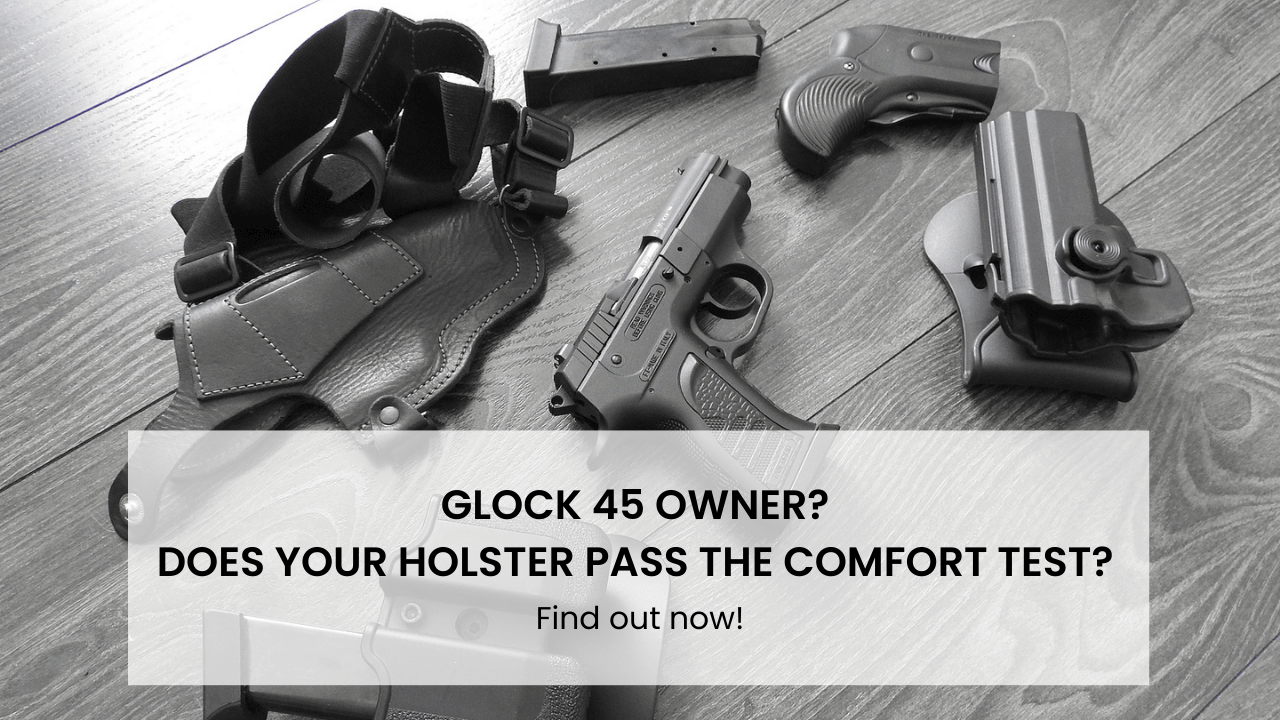Glock 48 IWB Holster Selection
Jun 7th 2021

The Glock 48 is a 9mm variant of the popular Glock series of firearms designed to accommodate a wide variety of different users. The Glock 48, featuring the company’s compact Slimline frame, is fed from a 10-round magazine.
Although the G48 is the same height and overall length as the Glock 19, it weighs almost three ounces less and has a narrower grip, owing to its single-stack magazine.
The Slimline series and Generation 5 features include a more pronounced beavertail, a magazine catch that you can reverse for ambidextrous functionality, and a low-profile carry.
The match-grade Glock Marksman Barrel (GMB) has polygonal rifling for improved accuracy, and the front and rear slide serrations provide additional traction for charging.
A gun of this caliber needs a suitable concealed-carry holster.
Glock 48 IWB Holster
The type of holster you should select for concealed carry should depend, first, on how you intend to carry it. IWB holsters sit between the waistband of your pants and your body, allowing for deep concealment. While some gun owners regard OWB (outside-the-waistband) holsters as more comfortable, OWB holsters require that you wear a jacket or a shirt over the weapon to keep it hidden.
How to Increase Concealment?
Once you’ve found a suitable gun holster, you may be wondering how you can increase the concealability of your firearm. You’ll need a gun belt. A proper gun belt should be durable and rigid, preventing the holster from canting outward. In addition to your choice of holster and gun belt, how you dress and move will also affect how well your weapon remains concealed. You want to minimize, as much as possible, the extent to which your gun "prints." Printing is when the outline of your firearm becomes visible through clothing.
Concealed Carry
Most Americans who carry firearms prefer concealed carry to open carry. There are a variety of tactical reasons for this. Concealed carry allows you to preserve the element of surprise. A criminal attacker selects the time and the place, but if he doesn’t know that you’re armed, he can’t plan accordingly.
Open Carry
If you're not interested in concealment, you can always carry your firearm openly, assuming that this is legal in your jurisdiction. Although popular with compact and full-size handguns, OWB or outside-the-waistband holsters are more appropriate for open carry.
The primary advantages of open carry are that it increases comfort and accessibility. The primary downsides are that it exposes your weapon, revealing your armed status, potentially renders you a target, and is more likely to cause alarm in those unfamiliar with or hostile toward firearms.
Hand Orientation
Some holsters are designed to be ambidextrous, usually by reversing some parts or screws. However, not every holster is equipped this way. When you're shopping for a holster, you should ensure that you find one specifically listed as appropriate for a right- or left-handed shooter.
Features of Our Glock 48 IWB Holsters
Cant and Ride Height Adjustment
The cant refers to the angle of rotation relative to your waistband. In a neutral or straight cant, the muzzle is vertical, pointing toward the ground. This is suitable for appendix carry. However, as the holster traverses the right hip, you will need an increasingly positive or forward cant to grip the weapon comfortably. A reverse cant, for a right-handed shooter, is necessary for cross draw carry.
The ride height is the height at which the holster rides on the belt relative to the waistband. The lower the ride height, the less space there is between the top of your gun belt and the front strap of the pistol frame.
When you find the position that’s right for you, you’ll need to find the ride height and cant, allowing you to consistently acquire a full firing grip on the weapon without sacrificing concealability. Our holsters are adjustable in both ways so that you can tailor the weapon to your preferences.
Multiple Carry Positions
Our line of holsters is designed to accommodate a wide variety of carry positions, including strong side, appendix carry, and cross draw. By experimenting, you can find the carry position that suits you best, and our line of Kydex holsters can help.
Kydex Construction
Introduced in the 1960s and originally designed for the aircraft industry, Kydex is an acrylic-polyvinyl chloride composite — a type of impact-resistant thermoplastic. In the 21st century, Kydex is a standard material for gun holsters and knife sheaths.
Kydex is increasingly gaining a footing in the firearms industry as a direct competitor against leather. Our Kydex holsters are precisely thermoformed to the specific firearm it’s designed to fit for a comfortable carry.
Adjustable Retention
Regardless of how you choose to carry your defensive weapon, you need to adjust the retention. Adjustable retention is less important in holster designs where you have to open a thumb break or rotate a hood to access your firearm.
However, in holsters that rely on a tight fit with no additional locking mechanism — i.e., passive retention — you can typically increase or decrease the amount of force needed to break the gun free. A snug fit, requiring a more forceful draw, may be right for your circumstances.
Full Sweat Shield
When the part of the holster closest to your body covers the slide, this is called a sweat shield or sweat guard. A partial or full sweat shield is designed to stop damp skin or clothing from contacting the handgun’s slide, as this may promote corrosion or mar the gun’s finish. If you’ve been firing your handgun at the range, performing practice drills, the sweat shield can also prevent you from being burned by the hot slide.
Fully Covered Trigger Guard
A carry holster should prevent you from inadvertently pressing the trigger until you have completed the draw stroke, clearing the holster mouth. A covered trigger guard also prevents clothing or equipment from contacting the trigger and unauthorized access.
Holstering “Click”
In leather holsters, you know that your gun is properly seated when its downward movement stops. In Kydex holsters, you also hear an audible “click” when you holster your firearm as the contact points snap into place. This kind of feedback can be useful under stressful situations.
Spare Ammunition

The G48 may be considered a relatively low-capacity weapon by the standards of some shooters. While ten rounds of 9mm ammunition are more than sufficient for most defensive shootings, you can never predict how many rounds you will need to repel or incapacitate a criminal assailant. Consequently, many gun owners choose to carry spare ammunition on the side of the belt accessible by the support hand.
A single- or double-magazine pouch, also known as a magazine carrier that you wear on or inside your waistband, can supply you with an additional 10 or 20 rounds for your G48. Open-top pouches made from Kydex offer the same passive retention as Kydex holsters, using one or two screws for adjustment.
If you intend to carry spare ammo for your carry gun, don’t neglect the importance of practice. Reloading drills can help you find weaknesses in your form or economy of motion, improving your efficiency in a real-world emergency.
Final Thoughts
At Incognito Concealment, we offer custom-molded Kydex holsters to fit a wide variety of firearms, including the popular Glock series. Give us a call so we can help you decide which holster design is best for you.
FAQs
What is the best IWB carry position?
The four IWB carry positions are strong side, appendix, cross draw, and small of the back. The most popular IWB carry positions are, however, strong side and appendix.
Also called “hip carry,” your strong side is your dominant side. Located on or behind your dominant hip, strong-side carry is comfortable for most shooters. It allows you to place your hand on your weapon discreetly, using your support hand to maintain distance between you and the threat. You can also fire from retention in this position, which can be highly invaluable at close range.
Although controversial due to safety concerns, appendix carry places the weapon in the front of your pants where it's most accessible. Ideal for a fast draw and convenient with tuckable holsters, appendix carry is one of the best carry options available.
What is the most comfortable IWB holster?
The most comfortable IWB Kydex holster is one that you can wear snugly and protects your body from the weapon. The only way for you to determine whether a holster is comfortable is for you to wear it. Don't wear a holster that causes you discomfort — it will discourage you from carrying.
Will a Glock 48 fit in a Glock 43X?
The Glock 48 will fit into a Glock 43X holster with an open bottom. Otherwise, you’ll need a holster specifically molded or cut for the G48.











